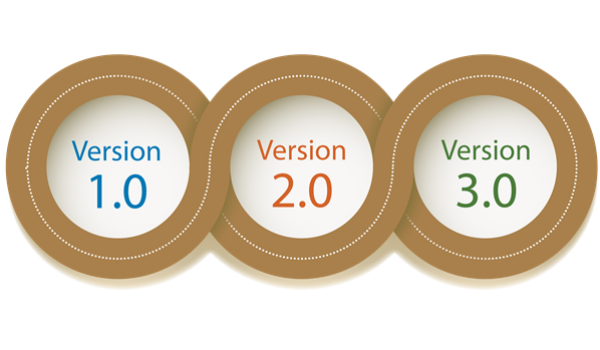View all of our courses and services
on findcourses.com
Sign up for free mini-courses
at our eLearning school
View all of our courses and services
on findcourses.com
Sign up for free mini-courses
at our eLearning school

Organizations around the world, from universities to non-profits to corporations, are branding themselves as innovative leaders. Search Google for “innovation” and you’ll find 516,000,000 entries. Search Amazon books and you’ll find over 115,000 books with “innovation” in the title.
“Being innovative” is fast becoming a required competency for every person, in every job, every day. In response, “enabling innovation” is fast becoming a necessary component of talent development programs, to give every person across an organization the knowledge, skills and opportunity to innovate to their highest human capacity.
Much like the evolution from mainframe computers to PCs to mobile devices… Innovation enablement has evolved over the past 100 years from 1.0 to 2.0 to 3.0. Here’s a brief overview of that shift…
With Innovation Enablement 1.0, the basic purpose for being innovative is to increase shareholder wealth. Specialists are assigned the innovation projects. Work is done in hierarchical silos, where “personnel” fit into pre-defined job descriptions and the focus is on maximizing productivity. Innovation training is focused on key people in critical functions. This approach started gaining popularity in the early 1900s, with the birth of “scientific management” by Frederick Taylor. Its strength is to optimize the innovativeness of the specialists and experts.
With Innovation Enablement 2.0, the purpose for being innovative expands to wealth creation for employees as well as shareholders. Those who have self-initiative are given innovative projects. Work roles are built around the unique talents of “human resources.” Innovation training is typically initiated by a function or project team, resulting in many unrelated interventions. This approach first gained recognition in the 1960s, fostered by Abraham Maslow’s hierarchy of needs and Douglas McGregor’s Theory X and Theory Y, as well as the TQM approaches of Kaoru Ishikawa, Dr. W. Edwards Deming and Philip Crosby. Its strength is to open up innovation competency-building to more people and expand the innovation opportunities to a broader range of people and functions.
With Innovation Enablement 3.0, the purpose for being innovative expands even further to the well-being of all stakeholders. Everyone is expected to be innovative in whatever job they do. People are “human capital” who often define their own roles. Innovation training has integrated models and interventions across functions, stakeholders and cultures. This approach began to gain credibility in the 1980s and is founded in holistic principles first espoused by Peter Senge, Peter Block, Stephen Covey, and Jay Wright Forrester. Its strength is to provide the knowledge, skills and opportunity for everyone in the organization to innovate to their highest capacity.
Each subsequent version includes the key strengths of the previous version - while adding new approaches and benefits. So version 3.0 contains the best of 1.0 and 2.0 – and it’s the version to embrace today, to enable innovation across your organization.
Innovation Enablement 3.0 is a game changer. It democratizes the mindset, behaviors, and opportunities to be innovative in every day work. It puts the power, responsibility, knowledge and tools for innovation at the fingertips of every employee – with a common language and understanding, integrated productivity tools, and processes that can be used across projects, functions, stakeholders, companies, industries, and cultures.
It’s time to ride this horse in the direction it’s already galloping!
[In 2018 a book chapter written by Debra and William Miller titled "Enabling Innovation with Human Values: A Recipe for Transformation" was published by Springer in a handbook titled "Handbook of Personal and Organizational Transformation." This extensive book chapter discusses the "10 Essential Ingredients" for Innovation Enablement 3.0. If you would like to review the chapter, please contact us.]